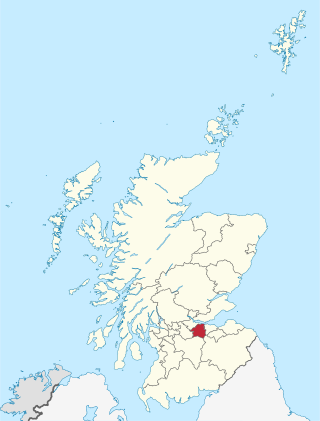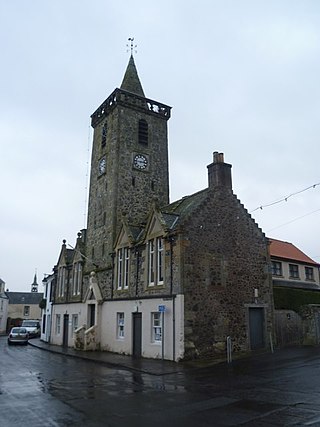
West Lothian is one of the 32 council areas of Scotland, and was one of its historic counties. The county was called Linlithgowshire until 1925. The historic county was bounded geographically by the Avon to the west and the Almond to the east. The modern council area occupies a larger area than the historic county. It was reshaped following local government reforms in 1975: some areas in the west were transferred to Falkirk; some areas in the east were transferred to Edinburgh; and some areas that had formerly been part of in Midlothian were added to West Lothian.

Parliament House in the Old Town in Edinburgh, Scotland, is a complex of several buildings housing the Supreme Courts of Scotland. The oldest part of the complex was home to the Parliament of Scotland from 1639 to 1707, and is the world's first purpose-built parliament building. Located just off the Royal Mile, beside St Giles' Cathedral, Parliament House is also the headquarters of the Faculty of Advocates, the Society of Writers to His Majesty's Signet, and the Society of Solicitors in the Supreme Courts of Scotland. Other buildings in the complex include the Advocates Library and the Signet Library. The entire complex is a Category A Listed building.

Linlithgow is a town in West Lothian, Scotland. It was historically West Lothian's county town, reflected in the county's historical name of Linlithgowshire. An ancient town, it lies in the Central Belt on an historic route between Edinburgh and Falkirk beside Linlithgow Loch. The town is situated approximately 20 miles (32 km) west of Edinburgh.

Dunfermline City Chambers is a municipal facility at the corner of Bridge Street and Kirkgate in Dunfermline, Fife. The building, which serves as home to the local area committee of Fife Council, is a Category A listed building.

Musselburgh Tolbooth is a municipal building in the High Street in Musselburgh, East Lothian, Scotland. The tolbooth, which was the headquarters of Musselburgh Burgh Council, is a Category A listed building. At right angles and attached to it is the Musselburgh Town House.

Haddington Town House is a municipal structure in Court Street, Haddington, East Lothian, Scotland. The structure, which is the meeting place of East Lothian Council, is a Category A listed building.

Bo'ness Town Hall is a municipal building in Stewart Avenue, Bo'ness, Scotland. The structure, which was the meeting place of Bo'ness Burgh Council, is a Category B listed building.

Alloa Town Hall is a municipal building in Marshill, Alloa, Scotland. The structure, which was the meeting place of Alloa Burgh Council, is a Category C listed building.

Wigtown County Buildings, also known as Wigtown County Buildings and Town Hall, is a municipal building in The Square, Wigtown, Scotland. The structure primarily served as the meeting place and town hall for Wigtown Burgh Council, but was also used for some meetings of Wigtownshire County Council. It is a Category B listed building.

Inverurie Town Hall is a municipal building in the Market Place in Inverurie, Scotland. The structure, which served as the meeting place of Inverurie Burgh Council, is a Category B listed building.

The County Buildings are in the High Street, Linlithgow, Scotland. The complex, which was the headquarters of West Lothian County Council, is a Category B listed building.

Galashiels Burgh Chambers is a municipal building in Albert Place, Galashiels, Scotland. The building, which was the headquarters of Galashiels Burgh Council, is a Category B listed building.

The Dunbar Town House, also known as Dunbar Tolbooth, is a municipal structure in the High Street in Dunbar, East Lothian, Scotland. The building, which currently operates as a museum, is a Category A listed building.

Cupar Burgh Chambers is a municipal structure in St Catherine Street in Cupar, Fife, Scotland. The building, which was the meeting place of Cupar Burgh Council, is a Category B listed building.

Dumbarton Municipal Buildings is a structure in Glasgow Road, Dumbarton, West Dunbartonshire, Scotland. The structure, which is used as a venue for weddings and civil partnership ceremonies, is a Category B listed building.

Gifford Town Hall is a municipal building in The Square, Gifford, East Lothian, Scotland. The structure, which is used as a community events venue, is a Category B listed building.

Dreel Halls is a municipal complex in Elizabeth Place, Anstruther Wester, Fife, Scotland. The complex, which is used as a community events venue, consists of the former St Nicholas's Parish Church, which is a Category A listed building, and the former Anstruther Wester Town Hall, which is a Category C listed building.

Auchtermuchty Town House is a municipal structure in the High Street, Auchtermuchty, Fife, Scotland. The structure, which accommodates the local public library, is a Category B listed building.

Crieff Town Hall is a municipal building in the High Street, Crieff, Perth and Kinross, Scotland. The structure, which is currently used as a tourist information centre and museum, is a Category B listed building.

County Buildings is a municipal structure in Court Street, Haddington, East Lothian, Scotland. The structure, which was the headquarters of East Lothian County Council and was also used as a courthouse, is a Category B listed building.





















